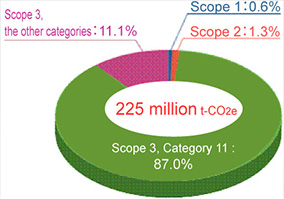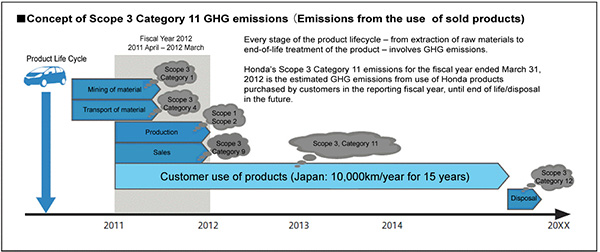TOKYO, Japan, August 25, 2012 - Honda Motor Co., Ltd. became the world's first*1 mobility company to disclose estimates of all greenhouse gas (GHG) emissions related to Honda including emissions from Honda's global business operations and customer use of Honda motorcycles, automobiles and power products.
By calculating and disclosing global GHG emissions as a responsible company engaged in the area of mobility, Honda will continue making proactive progress with its global initiatives to reduce GHG and further extend the Honda LCA (Life Cycle Assessment) approach.
The estimates of GHG emissions disclosed today by Honda were calculated in conformity with the Greenhouse Gas Protocol (GHG Protocol)*2, which are currently the most widely used international accounting standards to measure GHG emissions. The GHG Protocol defines three scopes of emissions by categorizing different business activities. Honda has been disclosing all Scope 1 and Scope 2 emissions since 2009 and disclosed a part of Scope 3 emissions (global Category 11 emissions) for the first time on June 20, 2012. With today's disclosure of all Scope 3 emissions, Honda has disclosed all GHG emissions defined by the GHG Protocol.
Moreover, Honda today also disclosed for the first time on its website (inside of web content titled the Environmental documentary, "Honda Face" currently available only in Japanese, URL:http://www.honda.co.jp/environment/face/2012/), conditions for the calculation of data required to determine Scope 3 Category 11 emissions, including customers' lifetime product use and annual traveling distance.
- *1Honda internal research
- *2GHG Protocol (the Greenhouse Gas Protocol) is guideline determined by the World Business Council for Sustainable Development and the World Resources Institute for GHG accounting.
Honda's GHG emissions during the fiscal year ended March 31, 2012
(Calculated in conformity with GHG accounting and reporting standards)
| Scope | Description | Emission (t-CO2e*3) |
Year/date of first disclosure by Honda | |
| Scope 1 | Direct emissions from operations that are owned or controlled by the reporting company (E.g. emissions from combustion of fuel oil at factories, emissions from corporate vehicles, etc.) |
1.24 million | June 2009 (global Scope 1 emissions) |
|
| Scope 2 | Indirect emissions from the generation of purchased or acquired electricity, steam, heating, or cooling consumed by the reporting company (E.g. electricity use at factories and offices, etc.) |
2.96 million | June 2009 (global Scope 2 emissions) |
|
| Scope 3 | Category 11 | Emissions from customer use of purchased products | 195.88 million | June 20, 2012 |
| Other categories | See the list on the next page | 24.98 million | Aug. 25, 2012 First among all mobility companies around the world |
|
| Indirect emissions not included in scope 1 or scope 2 | 220.86 million | |||
| Overall GHG emissions by Honda | 225.06 million | |||

- *3CO2e is an abbreviation for the "carbon dioxide-equivalent" which is calculated by converting six GHG substances defined in the Kyoto Protocol [carbon dioxide (CO2), methane (CH4), nitrous oxide (N2O), hydrofluorocarbons (HFCs), perfluorocarbons (PFCs) and sulfur hexafluoride (SF6)] into the equivalent of CO2.
Scope 3 GHG emissions by category
| Category | Item | Calculation scope |
| 1 | Purchased goods and services |
Extraction, production, and transportation of goods and services purchased or acquired by the reporting company in the reporting year, not otherwise included in Categories 2 – 8 |
| 2 | Capital goods | Extraction, production, and transportation of capital goods purchased or acquired by the reporting company in the reporting year |
| 3 | Fuel- and energy-related activities (not included in scope 1 or scope 2) | Extraction, production, and transportation of fuels and energy purchased or acquired by the reporting company in the reporting year, not already accounted for in scope 1 or scope 2 |
| 4 | Upstream transportation and distribution | ・Transportation and distribution of products purchased by the reporting company in the reporting year between a company's tier 1 suppliers and its own operations (in vehicles and facilities not owned or controlled by the reporting company) |
| ・Transportation and distribution services purchased by the reporting company in the reporting year, including inbound logistics, outbound logistics (e.g., of sold products), and transportation and distribution between a company’s own facilities (in vehicles and facilities not owned or controlled by the reporting company) | ||
| 5 | Waste generated in operations | Disposal and treatment of waste generated in the reporting company’s operations in the reporting year (in facilities not owned or controlled by the reporting company) |
| 6 | Business travel | Transportation of employees for business-related activities during the reporting year (in vehicles not owned or operated by the reporting company) |
| 7 | Employee commuting | Transportation of employees between their homes and their worksites during the reporting year (in vehicles not owned or operated by the reporting company) |
| 8 | Upstream leased assets | Operation of assets leased by the reporting company (lessee) in the reporting year and not included in scope 1 and scope 2 – reported by lessee |
|---|---|---|
| 9 | Downstream transportation and distribution | Transportation and distribution of products sold by the reporting company in the reporting year between the reporting company’s operations and the end consumer (if not paid for by the reporting company), including retail and storage (in vehicles and facilities not owned or controlled by the reporting company) |
| 10 | Processing of sold products | Processing of intermediate products sold in the reporting year by downstream companies (e.g., manufacturers) |
| 11 | Use of sold products | End use of goods and services sold by the reporting company in the reporting year |
| 12 | End-of-life treatment of sold products | Waste disposal and treatment of products sold by the reporting company (in the reporting year) at the end of their life |
| 13 | Downstream leased assets | Operation of assets owned by the reporting company (lessor) and leased to other entities in the reporting year, not included in scope 1 and scope 2 – reported by lessor |
| 14 | Franchises | Operation of franchises in the reporting year, not included in scope 1 and scope 2 – reported by franchisor |
| 15 | Investments | Operation of investments (including equity and debt investments and project finance) in the reporting year, not included in scope 1 or scope 2 |
- *Honda excludes Categories 8, 9, 13 and 14 emissions from the calculation of Scope 3 emissions for the following reasons;
- Category 8 (upstream leased asset) is included as a consumption by the reporting company (Scope 1 and Scope 2)
- Category 9 (downstream transportation and distribution) is included in Category 4 (upstream transportation and distribution)
- Category 13 (downstream leased asset) is included in Category 11 (use of sold products)
- Category 14 (franchises) is not applicable as Honda does not have any franchises
